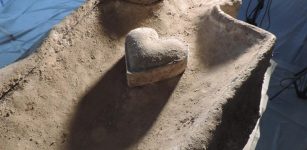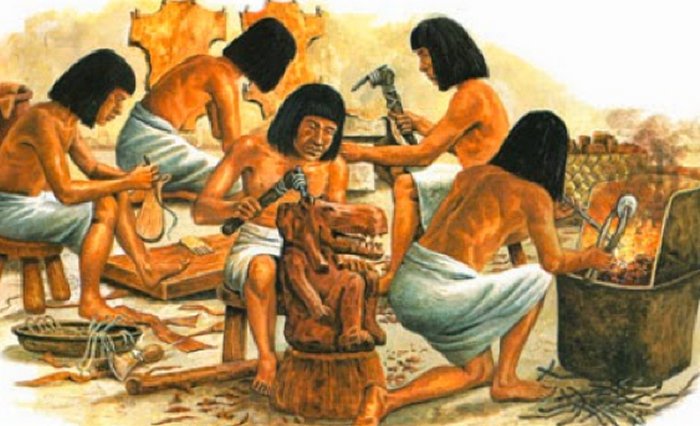What Ancient Civilization Discovered Metallurgy?
AncientPages.com - The science behind metallurgy goes far back in time, but it's uncertain when and where humans invented metal smelting.
Researchers now think they have found the answer to this long-debated question in the history of technology. Apparently, metallurgy does not have a single origin, but probably arose at various locations at about the same time.
The experts reached this conclusion after re-examining the 8,500-year-old copper slag and analyzing the chemical composition of other copper artifacts from the Stone Age settlement of Çatalhöyük in the Near East.
Scientists have debated for a long time who discovered metallurgy.
There is evidence copper metal was already being processed at the beginning of the Neolithic Age approximately 10,000 years ago in the Fertile Crescent from the Levant through East Anatolia to the Zagros Mountains in Iran.
"But because this is all pure, native copper, we can't really call it true metallurgy," explains Prof. Dr Ernst Pernicka, Scientific Director of Heidelberg University's Curt Engelhorn Centre for Archaeometry, which is located in Mannheim.
Copper is found in nature as metal, and according to the researchers, was probably considered a special type of stone. But because the production of metal from ore ushers in a new era in human history, it is important to know when and where it first developed and whether metal smelting really originated in a single location.
See also:
Aluminum Was Used At Least 7,000 Years Ago – Long Before The Metal’s Official Invention In 1825
Telangana And Great Ancient Iron Masterwork Of Skilled Blacksmiths Of India
It was long believed that a small amount of copper slag from the Neolithic site at Çatalhöyük was thought to be the earliest evidence for pyrometallurgical extraction of copper from ore.
This settlement existed from approximately 7,100 to 6,000 BC and is considered to be the most significant site in the Near East that affords any insight into the development of human habitats. The copper slag was located in layers that dated back to 6,500 years before Christ and was therefore 1,500 years older than the world's earliest evidence of copper smelting.
Copper bead from Çatalhöyük. It consists of very pure copper in metal form, as found in nature. Image credit: Picture: M. Radivojevic, CC BY-NC-SA 3.0
"The find seemed to point to the birthplace of metallurgy, with the technology slowly spreading from there in all directions," states Prof. Pernicka, who also heads the Archaeometry and Archaeometallurgy Research Group at the Institute of Earth Sciences at Heidelberg University.
However new studies, including those at the Curt Engelhorn Centre for Archaeometry, have demonstrated that the slag was an unintentional by-product of a domestic fire. The extreme heat of the fire slagged the green copper ores, which were used as pigment. The slag differs in chemical composition from another artefact from the Stone Age settlement, a bead of folded sheets made of pure copper.
This threw new light on the scientific significance of the copper slag of Çatalhöyük, now putting the earliest known examples of copper extraction from ore around 5,000 BC in Southeast Europe and Iran.
The current findings indicate that this revolutionary development in humankind probably came about at roughly the same time but in multiple locations. "We thereby solved a controversial problem in the history of technology," underscores Professor Pernicka.
AncientPages.com
Expand for referencesMore From Ancient Pages
-
 Remarkable discovery: Ancient coffins reveal centuries-old secrets of French nobility
News | Sep 1, 2015
Remarkable discovery: Ancient coffins reveal centuries-old secrets of French nobility
News | Sep 1, 2015 -
 DNA From Doggerland That Separates The UK From Europe – New Study
Archaeology | Jul 20, 2020
DNA From Doggerland That Separates The UK From Europe – New Study
Archaeology | Jul 20, 2020 -
 Orang Bunian: Mysterious Invisible Whistle People Living In Forests In Malay Folklore
Featured Stories | Jul 15, 2016
Orang Bunian: Mysterious Invisible Whistle People Living In Forests In Malay Folklore
Featured Stories | Jul 15, 2016 -
 Carved Symbols Related To The Galician Castro Culture Discovered At Castro de San Vicenzo, Orense, Spain
Archaeology | Oct 11, 2024
Carved Symbols Related To The Galician Castro Culture Discovered At Castro de San Vicenzo, Orense, Spain
Archaeology | Oct 11, 2024 -
 Apulian Secrets: Ancient Burial Rituals Shed Light On A Culture That Left No Written History
Archaeology | Jan 12, 2016
Apulian Secrets: Ancient Burial Rituals Shed Light On A Culture That Left No Written History
Archaeology | Jan 12, 2016 -
 Neanderthal Cave Engravings Identified As Oldest Known, More Than 57,000 Years Old
Archaeology | Jun 22, 2023
Neanderthal Cave Engravings Identified As Oldest Known, More Than 57,000 Years Old
Archaeology | Jun 22, 2023 -
 Mysterious Hieroglyphs Point To The Location Of Queen Nefertiti’s Tomb?
Archaeology | Sep 29, 2022
Mysterious Hieroglyphs Point To The Location Of Queen Nefertiti’s Tomb?
Archaeology | Sep 29, 2022 -
 More Than 1, 300 Prehistoric Burial Mounds In Western Azerbaijan Have Been Systematically Surveyed For The First Time
Archaeology | Dec 19, 2024
More Than 1, 300 Prehistoric Burial Mounds In Western Azerbaijan Have Been Systematically Surveyed For The First Time
Archaeology | Dec 19, 2024 -
 World’s Oldest Tattoo Tools Discovered In Tennessee, North America
Archaeology | May 2, 2018
World’s Oldest Tattoo Tools Discovered In Tennessee, North America
Archaeology | May 2, 2018 -
 Surprising Discovery Of 88 Ice Age Human Footprints In Utah Desert
Archaeology | Jul 26, 2022
Surprising Discovery Of 88 Ice Age Human Footprints In Utah Desert
Archaeology | Jul 26, 2022 -
 How Did Climate Change Impact European Ice Age Humans?
Earth Changes | Aug 21, 2024
How Did Climate Change Impact European Ice Age Humans?
Earth Changes | Aug 21, 2024 -
 Incredibly Rare Iron Age Wooden Objects Discovered In 2,000-Year-Old Waterlogged Site In The UK
Archaeology | Jan 21, 2023
Incredibly Rare Iron Age Wooden Objects Discovered In 2,000-Year-Old Waterlogged Site In The UK
Archaeology | Jan 21, 2023 -
 Never-Before-Seen Structures Of King Herod’s Magnificent Palace Herodium Unveiled
Archaeology | Dec 11, 2020
Never-Before-Seen Structures Of King Herod’s Magnificent Palace Herodium Unveiled
Archaeology | Dec 11, 2020 -
 Searching For Dilmun: Underwater Ruins In The Persian Gulf Predate The Pharaohs And Sumer
Civilizations | Apr 24, 2023
Searching For Dilmun: Underwater Ruins In The Persian Gulf Predate The Pharaohs And Sumer
Civilizations | Apr 24, 2023 -
 Understanding The Green Sahara’s Collapse
Earth Changes | Aug 22, 2024
Understanding The Green Sahara’s Collapse
Earth Changes | Aug 22, 2024 -
 Fall Equinox Explains Unusual Alignment Of Egypt’s Great Pyramids – Engineer Says
Archaeology | Feb 26, 2018
Fall Equinox Explains Unusual Alignment Of Egypt’s Great Pyramids – Engineer Says
Archaeology | Feb 26, 2018 -
 What Was Life For Ancient Viking Children?
Ancient History Facts | Nov 1, 2016
What Was Life For Ancient Viking Children?
Ancient History Facts | Nov 1, 2016 -
 Riddle Of Two Undeciphered Elamite Scripts
Featured Stories | May 19, 2021
Riddle Of Two Undeciphered Elamite Scripts
Featured Stories | May 19, 2021 -
 Ancient Dance And Games Offer Glimpses Of Life And Death In Italy 2,500 Years Ago
Archaeology | Mar 24, 2023
Ancient Dance And Games Offer Glimpses Of Life And Death In Italy 2,500 Years Ago
Archaeology | Mar 24, 2023 -
 Never-Before-Seen Magnificent 2,000-Year-Old Second Temple Found By Western Wall In Jerusalem Revealed To The Public
Archaeology | Jul 29, 2021
Never-Before-Seen Magnificent 2,000-Year-Old Second Temple Found By Western Wall In Jerusalem Revealed To The Public
Archaeology | Jul 29, 2021


